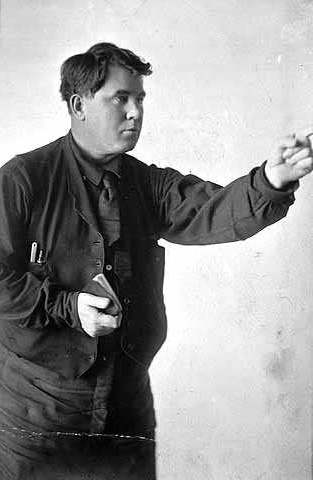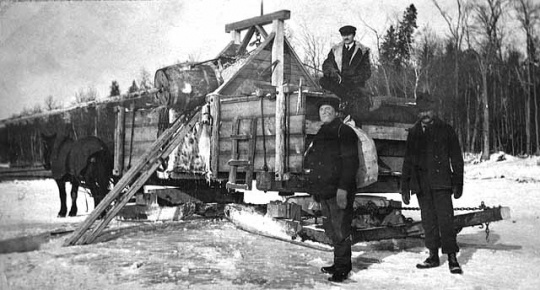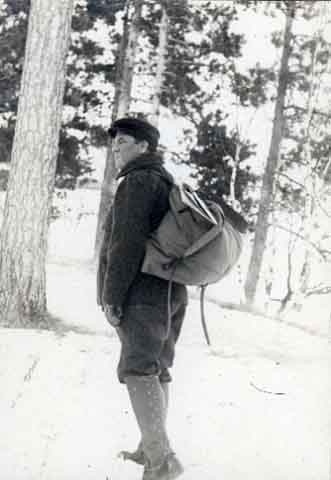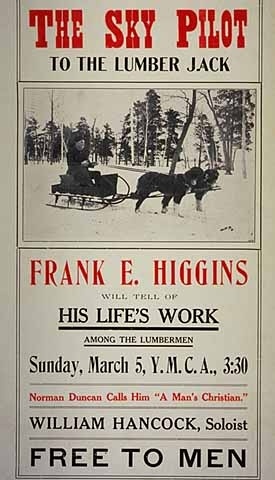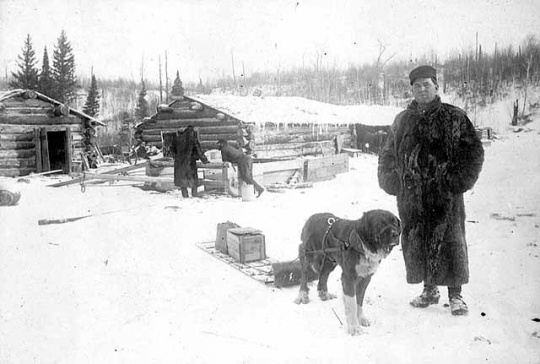Frank Higgins, the original lumberjack sky pilot, ministered to the souls of lumberjacks across northern Minnesota and the United States. For decades he traveled among the frozen logging camps of Minnesota with his trademark pack of Bibles, hymnals, and Christian literature strapped to his back.
Higgins knew he wanted to become a minister from a young age, but a lack of education almost kept him from his dream. Born in Toronto, Ontario in 1865, Higgins had to leave school after fifth grade in order to help his family farm.
After a religious experience at age eighteen, Higgins decided to become a Christian minister. He knew, however, that he would need more education. At age twenty, he went back to school, beginning in the sixth grade. He continued for five years, finishing his sophomore year of high school.
In 1890, Higgins moved to Minnesota to become a lay Methodist preacher in Annandale. He enrolled at Hamline University in St. Paul in 1893 but did poorly in his studies. Ultimately, the Methodist church decided he was not suitable for their clergy.
In 1895, the Presbyterian congregation in Barnum invited Higgins to preach while continuing to study for ordination. Barnum, a town less than fifty miles from Duluth, built the church to serve area farmers and lumbermen, the owners and operators of logging companies.
One of those lumbermen took Higgins out to his lumber camps in the Kettle River area. After introducing Higgins to the lumberjacks, one of them asked for a sermon on the spot. Higgins did his best to recall a sermon, and he impressed the men greatly.
For several years, Higgins visited logging camps from his base church in Barnum. In 1899, however, he dedicated himself completely to logging camps. That winter, he prayed with a dying lumberjack in a Duluth hospital. The logger urged Higgins to do more for the lumberjacks.
Several weeks later, Higgins resigned from his church ministry. He moved to Bemidji, which had a reputation as one of the roughest towns in the North Woods. Bemidji was home to many saloons, brothels, and gambling joints, and Higgins was determined to change it. Logging camp operators invited Higgins and other sky pilots to speak to their workers. They thought that lumberjacks who found God and gave up drinking and gambling were more efficient workers.
Higgins was accepted by lumberjacks because he seemed like one of them. He was physically imposing, and his friends said he occasionally punched men who confronted him. Higgins was well-prepared for the cold winters. At first, as he traveled across northern Minnesota from camp to camp, he used snowshoes or skies and carried a heavy pack on his back. He later realized that a dog-drawn sled would be easier for hauling his materials. It was also easier for taking injured lumberjacks and pregnant women to the nearest hospital. Higgins and his sled dogs became an iconic image in the North Woods.
Higgins began recruiting new sky pilots from the ranks of converted lumberjacks. The most famous was John Sornberger, a former prize fighter who had become a heavy drinker and murderer. Higgins helped the wanted criminal find God, give up sin, and clean up his life. Higgins even engineered a pardon from Governor John Johnson.
In 1902, Higgins was asked to head a Presbyterian home mission program to logging camps. The camps covered over 200 square miles and included 30,000 men, which was too much for one minister. Higgins began sending other sky pilots on camp circuits.
Higgins's reputation was growing, and in 1909 he became a full-fledged celebrity. Norman Duncan wrote a profile of Higgins in Harpers magazine, and Higgins began receiving invitations to speak all over the United States. He spoke to church groups in the Northeast, and to lumberjacks in the Pacific Northwest. While he was in Washington state, he even encountered lumberjacks that he knew from Minnesota.
In 1914, after years of carrying a heavy backpack, Higgins developed a pain in his shoulders that would not go away. It was sarcoma, a form of cancer, and doctors told him it was caused by carrying his pack. He had several operations but passed away on January 4, 1915, at the age of forty-nine.








